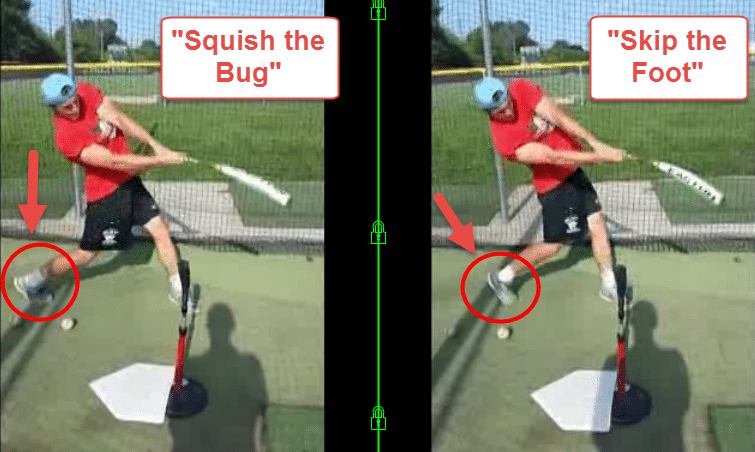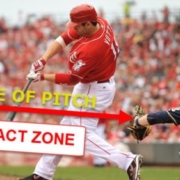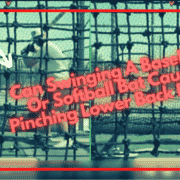Youth Hitting Fundamentals Why Squishing Bug Bad For Baseball & Softball In 2022? | Basic How To Hit In Certain Direction Beginner Swing Tips Experiment For 10 Years Olds & Younger
Baseball Swing Mechanics Experiment: Squash The Bug Ineffective?
This post discusses youth hitting fundamentals of why squishing the bug is bad for baseball and softball players in 2022? Learn basic how to hit the ball in a certain direction beginner swing tips experiment. This information is great for 10-year old’s and younger.
Question: Do “Squish the Bug” Baseball Swing Mechanics Depress Bat Speed?
Using the Zepp (Labs) Baseball app, I wanted to use the Scientific Method to analyze if the baseball swing mechanics “squishing/squashing the bug”, during the turn, increases or decreases bat speed. The term “squishing the bug” means rotating the back foot, on the ground, during the turn. Like you’re squishing a bug.
This can be a very sore subject, and hotly debated with a passion, in the Church of Baseball. Surprisingly, it’s still widely taught throughout the lower levels. Although a few images off the internet of effective swingers like Cano, Bautista, McCutchen, etc. will reveal “squishing the bug” isn’t what the best are doing.
So we wanted to test it…
My intern for the summer, redshirt college freshman Tyler Doerner did this experiment. This post is for you Joe (you know who you are ;-)…
Background Research
One of the main objectives of whether to skip the foot, or keep it on the ground, has to do with transferring linear momentum, better known as un-weighting or forward momentum. Check out these four HPL posts for a baseball swing mechanics background on this:
- Troy Tulowitzki Zepp Swing Experiment: Stride Killing Bat Speed?
- Ryan Braun: Common Mistakes Hitters Make #1
- Baseball Hitting Video: Gain Distance the Easy Way PART-1
- Perfect Swing Hacking with Forward Momentum (feat. Mike Trout)
Now, for you academics, CLICK HERE to watch a short 2-minute PBS video on Circus Physics and the Conservation of Linear Momentum.
So, after reading/watching the above videos and posts, we should be at a common understanding of Forward Momentum.
The next objective of “squishing the bug” versus “skipping the back foot” during the turn, boils down to allowing the body to transfer energy effectively. This has to do with springy fascia in the body…
In Thomas Myers’s book Anatomy Trains, he talks about a cotton candy like springy material that the bones and muscles float it, and what gives muscles their shape called fascia.
Specifically in the book, he talks about the Front & Back Functional Lines. CLICK HERE for a post I did on this, featuring Ted Williams and Matt Kemp.
In the following video, Thomas Myers explains this idea of Tensegrity, or Tension-Integrity. There are compression and tension forces acting on the body at all times. Within the body these two opposing forces are always searching for balance…
For a hitter, if the body moves forward, but the back foot and leg stays behind, then these forces don’t get optimally transferred from body to barrel to ball. In other words, the backside gets “left behind”.
Hypothesis
Based on the above research, I think “squishing the bug” baseball swing mechanics will have a depressing effect on bat and hand speed because it doesn’t allow for full transfer of momentum and release of elastic energy in the springy fascia.
“Squish the Bug” Baseball Swing Mechanics Experiment
Equipment Used:
- Zepp Baseball app
,
- Tanner Tee
,
- Camera Phone and Coaches Eye app, and
- Easton comp bat.
Setup:
- Forward momentum was taken out of this baseball swing mechanics experiment by hitting from a 1-2 second pause at landing
- Back two “baseball markers” were set at about 3 baseballs apart
- The two tests in the experiment were counter-balanced. Which consisted of eight blocks of 25-swings done in the following order ABBA BAAB. Say “squish the bug” was letter ‘A’, and “skipping back foot’ was letter ‘B’. 200 total swings were completed in the experiment, 100 per test. Counter-balancing helps remove the “getting tired” and “not being warmed” up factors.
Data Collected (Zepp Baseball App):

There were significant changes in Average Bat & Hand Speed, Time to Impact, and surprisingly, the hitter’s Attack Angle in this baseball swing mechanics experiment…
Data Analysis & Conclusion
- +8-mph difference in average Impact Bat Speed, siding on “Skipping Back Foot”,
- +3-mph difference in average Hand Speed Max, siding on “Skipping Back Foot”,,
- -0.019 difference in average Time To Impact, siding on “Skipping Back Foot”, and
- +4-degree difference in average Attack Angle, siding on “Skipping Back Foot”.
Notes
- I think the “Squish the Bug” baseball swing mechanics experiment results were overwhelmingly clear.
- Tyler did not technically keep his back foot posted to the ground during the “squish the bug” tests, so there still was an element of un-weighting going on with his backside.
- In which case, measuring Ball Exit Speed (or how fast the ball came off the bat) may have netted interesting data to consider, compared to Impact Bat Speed. However, with the results with the other readings of Avg. Hand Speed, Time To Impact, and Attack Angle, I think we can put the “Squish the Bug” baseball swing mechanics myth to bed 😀
- The data and results suggests that when a hitter “leaves behind their backside”, there’s a slowing down of forward momentum, and the body naturally decelerates because the springy fascia is forced to stretch, but not release.
- Keep in mind what I call the Goldilocks Syndrome. The back foot can skip too far (porridge too hot), and it can also not skip at all (porridge too cold). We want the back foot to skip just right.
The Bottom Line?
In this “Squish the Bug” baseball swing mechanics experiment, “Skipping the Back Foot” showed a notable difference in average Bat & Hand Speed, Time To Impact, and the hitters Attack Angle. I want to encourage you to tinker and test this for yourself. The objective of these swing experiments is to put modern hitting theory to the test, literally. We NEED to test based on data, not feelings. Share these results with friends.
- Fix Your Child’s Fear of the Ball Fast: Proven Hitting Drills to Stop Flinching at Pitches—Trusted by Top Youth Baseball Coaches - July 12, 2025
- Fix Your Little Leaguer’s Hitting Slump Fast – Proven Confidence Drills & Mental Reset Tools (Used by Top Youth Baseball Coaches) - July 9, 2025
- Best Hitting Drills for 8-Year-Olds (2025): Fix Swing Flaws Fast with This MLB-Trusted Youth Baseball System—At-Home, Step-by-Step, and Built for Game-Day Confidence - July 5, 2025













Great job, Joey! I guess it’s me you refer to. Thanks, makes me feel important and gives me street creds as a critic. But I do believe that Mike Scioscia would know that intuitively. Certainly Ted Williams would. 😉
Just kidding. I do believe in your methods but I believe there is something to be said for trusting your intuition. There are “spirits in the material world” as The Police once sang.
Keep up the could work. I could have used your research in combating the “squish the bug” heresy about 15 – 20 years ago. Your website, products, articles, and experiments have made a significant contribution to the science of hitting. But don’t forget the art aspect of it.
I appreciate the kind words and advice Joe. And yes, this experiment was meant for you because of the “skipping back foot” stuff you’ve sent over to me 😛 I agree, I wished to have had this stuff sooner too. Could have catapulted me into pro ball for sure.
That’s keep up the good work.
Strange, but that’s not how they taught “squish the bug ” at first. Dusty Baker”s video series, “You Can Teach Hitting,” taught it as being the first thing a hitter did! God !
Sheesh! Yeah, I remember that book, got a lot out of it at the time. Tyler D. in the experiment, didn’t exactly keep contact with the ground, for a conventional “squishing of the bug”. But imagine if he did, and how much of a difference there would’ve been in the data 😉
That’s my point – the way “squishing the bug” was originally taught was “one of the first things a hitter does!” It was taught as occurring pre-final turn, pushing the hips open, not a torquing action. I remember the guy saying it in the video. Do you know how many people bought into that? A lot!
Joey,
A good book for you to read about the intuition vs data argument is Daniel Kahneman’s “Thinking, Fast and Slow.” Check it out.
Joe
Please enlighten me here boys. This ‘Squishing the bug’ thing is confusing to me. I take it that means rotating/turning over your back foot in a motion that resembles squishing a bug (you could also call it ‘Putting out a cigarette!’). Anyway … I can’t see any way around doing that. The turning/rolling over of the back foot is essential or you’ll end up with a serious situation of reciprocal inhibition in a few areas.
Thanks Joe for the book, I’ll check it out 🙂 Bob, yes the back foot must roll over to let the pelvis clear. The problem is that coaches teach that the back foot must remain on the ground, and to weight it.
Oh … Really? Why would you want to do that? That doesn’t make sense. You have to get off your back foot – just like throwing.
Joey,
So my observation that great hitters skip their foot cause this?
Bob and Joey,
Hitters always skipped the back foot. We just didn’t have the video clips to watch them.
Bob, check out clips of Mantle, Mays, Aaron, and Canseco and watch them in slomotion to see their back foot skip into contact.
Bob,
Sorry, you can find clips of those guys on youtube.
Bob, I don’t know why they’d want to do that in this day and age of technology and high speed video cameras. Keep the hitters weight back and back foot firmly planted in the ground isn’t clearly what the best do.
Joe – It’s not an absolute the skip the back foot, some hitters come up on their toe (Pujols and Pedroia), while others skip (some of the ones you mentioned, plus some). I like to teach the skip, for the reason of this experiment. Although, a hitter can skip the back foot too much and end up above the pitch plane.
Pujols skips it now. Check out the clip on youtube with the Angels.
Cool to see the evolution of his swing recently.
No one has changed or adjusted his swing as much as Pujols. I was watching tape I had of him from 2002, his 2nd year in the majors. What a difference!
Pujols is a student of the game. Always looking for an edge. I wonder if he works with a hitting coach, or makes most of those changes himself…
Joey,
I don’t think he would tell us. Although, I could see the changes made while he was in St. Louis when Hal McRae, a Lau disciple, was the hitting coach. He has since gotten away from those mechanics. Today, with the Angels, he is more compact and utilizes a stride, except with two strikes, when he uses a no stride.
Try to get Pujols on here. That would be interesting.
That would be interesting Joe, and I’ll work on it 🙂